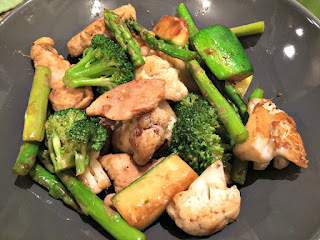Stir-Fry's are a 'quick and easy' weeknight meal, and I find they're a great way to use up any leftover meats and small amounts of veggies left in your crisper. For Christmas this year, I received a new Wok! I have never owned an actual wok before, and having one inspired me to do some research and experimenting in search of the perfect stir fry technique!
I hope these tips will help you take your stir-fry game to a new level of delicious!
Tips for the perfect stir-fry
1. Don't crowd the wok/skillet. This will result in the veggies sweating and steaming rather than stir frying and they won't get that delightful tender-crisp texture. This means you may need to do 2 or 3 batches if you are feeding a large family or want leftovers for lunch.
2. Use an oil that is suitable for higher heat cooking. Oils such as extra virgin olive oil, hemp or flax oil have a low smoke point, and using them for medium-high heat cooking will cause them to smoke and give "off" flavours. The following oils have a higher smoke point and are better for stir frying:
- vegetable oil
- corn oil
- peanut oil
- safflower or sunflower oil
3. Cut all your vegetables into equal bite-size pieces. This will allow them to cook quickly and in the same amount of time. Meat should be cut into thin bite-size pieces or strips, and can be fully cooked in the wok first, then removed before the veggies are added. The following work well in stir-fry's:
cauliflower
celery
carrots
baby corn
asparagus
bok choy
zucchini
mushrooms
peppers
eggplant
chicken (breast or thigh) or turkey
tender lean beef or pork
salmon
tofu
4. Make sure your vegetables are dry. Water left on vegetables could cause them to steam, which could make them too soft.
5. Keep stirring! A stir fry doesn't take long to cook, but needs to be stirred constantly. Make sure you have all your ingredients prepared and handy before you start cooking, as you won't have time to leave the pan unattended.
6. Sauce wisely. Soy sauce (and others such as fish, oyster, hoisin, or jarred stir fry sauces) are very high in sodium, and a little goes a long way! I used 1 tsp of soy sauce added right at the end of cooking time. Try other healthy seasonings for your stir fry, such as:
- Grated/ground ginger
- Minced or sliced garlic
- Fresh herbs: basil, cilantro
- Spices: cumin, garam masala, cardamom
- Fruit juices
- Citrus zest
- Low sodium broths
- Hot sauce or chili sauce
- Sesame seeds
The Perfect Stir Fry
Makes 2 - 3 servings
Makes 2 - 3 servings
- 1 tbsp oil (see tip #2 above)
- 4 cups vegetables, cut into bite size pieces
- 1 clove garlic, minced
- 4 - 6 ounces lean meat, sliced into bite-size pieces
- sauce and seasoning of your choice (I used 1 tsp each of fresh ginger and soy sauce)
Gather your vegetables together. Wash and dry them.
Chop vegetables into equal size pieces. Mince garlic. Gather/measure all seasonings and sauces.
Prepare the wok (or large skillet) by heating it to medium high heat, then add your oil and let it heat up. I added the garlic first, but it did get a bit overcooked. Next time I would either cook the garlic and then remove it from the pan, or add it in the last minute of cooking along with the ginger.
If you are cooking a protein in your stir fry, add it now, cook completely, then remove from the wok while you cook your vegetables. I was using leftover cooked chicken breast, so I will add this at the end.
Start adding your vegetables. Group vegetables with similar cooking time together. I added the cauliflower and broccoli first and cooked them for 1 - 2 minutes on their own as they are a bit more tough and firm.
Add the remaining vegetables and cook for another 2 minutes.
Continue to stir constantly.
When vegetables are tender-crisp, add your cooked meat or protein back to the wok.
Add seasonings/sauce. I used 1 tsp fresh grated ginger and 1 tsp of soy sauce.
Remove from the heat. Serve over quinoa, brown rice, or noodles.
Enjoy!
Natalee RD












Comments
Post a Comment